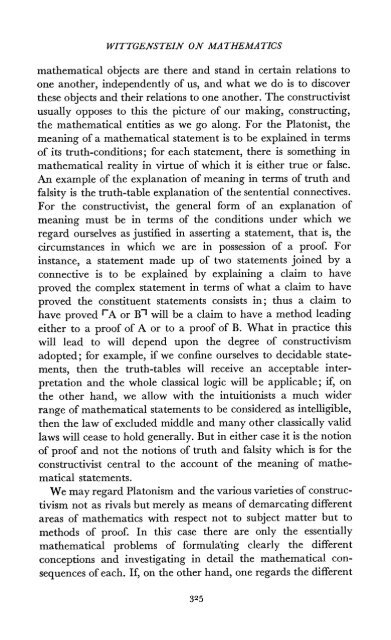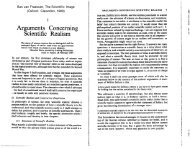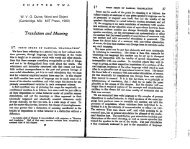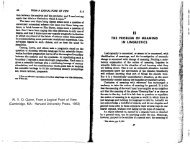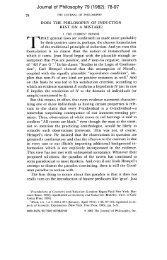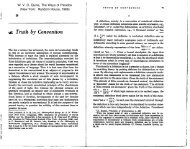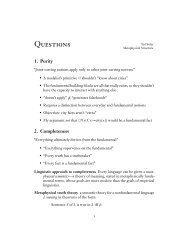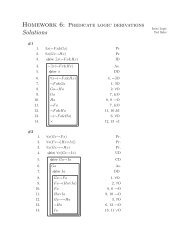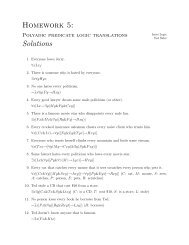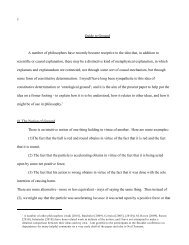Dummett - Wittgenstein's Philosophy of Mathematics.pdf - Ted Sider
Dummett - Wittgenstein's Philosophy of Mathematics.pdf - Ted Sider
Dummett - Wittgenstein's Philosophy of Mathematics.pdf - Ted Sider
Create successful ePaper yourself
Turn your PDF publications into a flip-book with our unique Google optimized e-Paper software.
WITTGENSTEIN ON MATHEMATICS<br />
mathematical objects are there and stand in certain relations to<br />
one another, independently <strong>of</strong> us, and what we do is to discover<br />
these objects and their relations to one another. The constructivist<br />
usually opposes to this the picture <strong>of</strong> our making, constructing,<br />
the mathematical entities as we go along. For the Platonist, the<br />
meaning <strong>of</strong> a mathematical statement is to be explained in terms<br />
<strong>of</strong> its truth-conditions; for each statement, there is something in<br />
mathematical reality in virtue <strong>of</strong> which it is either true or false.<br />
An example <strong>of</strong> the explanation <strong>of</strong> meaning in terms <strong>of</strong> truth and<br />
falsity is the truth-table explanation <strong>of</strong> the sentential connectives.<br />
For the constructivist, the general form <strong>of</strong> an explanation <strong>of</strong><br />
meaning must be in terms <strong>of</strong> the conditions under which we<br />
regard ourselves as justified in asserting a statement, that is, the<br />
circumstances in which we are in possession <strong>of</strong> a pro<strong>of</strong>. For<br />
instance, a statement made up <strong>of</strong> two statements joined by a<br />
connective is to be explained by explaining a claim to have<br />
proved the complex statement in terms <strong>of</strong> what a claim to have<br />
proved the constituent statements consists in; thus a claim to<br />
have proved rA or B1 will be a claim to have a method leading<br />
either to a pro<strong>of</strong> <strong>of</strong> A or to a pro<strong>of</strong> <strong>of</strong> B. What in practice this<br />
will lead to will depend upon the degree <strong>of</strong> constructivism<br />
adopted; for example, if we confine ourselves to decidable state-<br />
ments, then the truth-tables will receive an acceptable inter-<br />
pretation and the whole classical logic will be applicable; if, on<br />
the other hand, we allow with the intuitionists a much wider<br />
range <strong>of</strong> mathematical statements to be considered as intelligible,<br />
then the law <strong>of</strong> excluded middle and many other classically valid<br />
laws will cease to hold generally. But in either case it is the notion<br />
<strong>of</strong> pro<strong>of</strong> and not the notions <strong>of</strong> truth and falsity which is for the<br />
constructivist central to the account <strong>of</strong> the meaning <strong>of</strong> mathe-<br />
matical statements.<br />
We may regard Platonism and the various varieties <strong>of</strong> construc-<br />
tivism not as rivals but merely as means <strong>of</strong> demarcating different<br />
areas <strong>of</strong> mathematics with respect not to subject matter but to<br />
methods <strong>of</strong> pro<strong>of</strong>. In this- case there are only the essentially<br />
mathematical problems <strong>of</strong> formulating clearly the different<br />
conceptions and investigating in detail the mathematical con-<br />
sequences <strong>of</strong> each. If, on the other hand, one regards the different<br />
325


